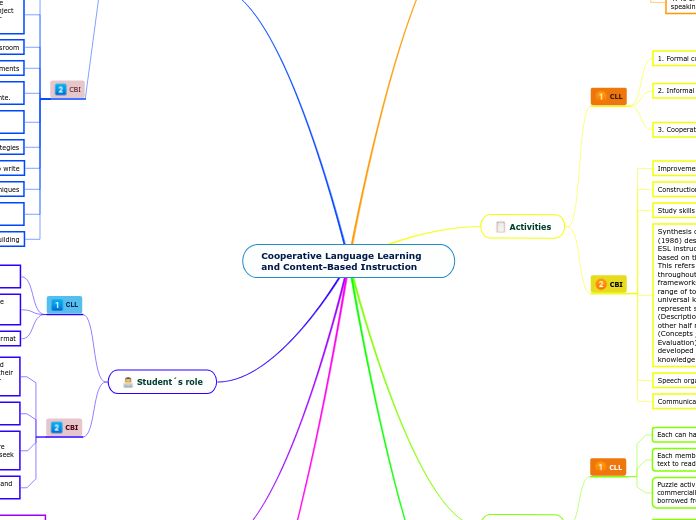Cooperative Language Learning and Content-Based Instruction
Characteristics
CLL
Encouraging cooperation rather than competition, to develop critical thinking skills and to develop communicative competence through socially structured interaction activities, these can be considered as the overall objectives of the CLL
CBI
1. To activate and develop existing English language skills
2. Acquire learning skills and strategies that can be applied in future language development opportunities.
3. Develop general academic skills applicable to university studies in all subject areas.
4. To broaden students' understanding of English-speaking peoples (Brinton et al., 1989: 32)
Activities
CLL
1. Formal cooperative learning groups.
These last from one class period to several weeks. These are set for a specific task and involve students working together to achieve shared learning goals
2. Informal cooperative learning groups.
These are ad-hoc groups that last from a few minutes to a class period and are used to focus students' attention or to facilitate learning during direct teaching.
3. Cooperative grassroots groups.
These are long-term, last at least one year, and consist of heterogeneous learning groups with stable membership whose primary purpose is to enable members to give each other the support, help, encouragement, and assistance they need to succeed academically.
CBI
Improvement of language skills
Construction of vocabulary
Study skills
Synthesis of contents and grammar. Mohan (1986) describes an approach to content-based ESL instruction at the secondary level that is based on the notion of knowledge structures. This refers to the structures of knowledge throughout the curriculum in terms of frameworks and schemas that apply to a wide range of topics. The framework consists of six universal knowledge structures, half of which represent specific practical elements (Description, Sequence and Choice) and the other half represent general theoretical elements (Concepts / Classification, Principles and Evaluation). A variety of CBI courses have been developed based on Mohan's framework of knowledge.
Speech organization
Communicative interaction
Materials
CLL
Each can have a set of materials
Each member of the group may need a copy of a text to read and consult.
Puzzle activities and information gaps that are sold commercially, modified from existing materials, or borrowed from other disciplines.
CBI
Turistic guides
Technical magazines
Train schedules.
Newspaper ads.
“Provide guides and strategies to help [students] understand the materials” (Brinton et al., 1989: 17).
These arose in
CLL
In the 1960s and 1970s in the USA
CBI
In the 1980s
Teacher's role
CLL
The teacher must create a highly structured and well-organized learning environment in the classroom, setting goals, planning and structuring tasks, establishing the physical layout of the classroom, assigning students to groups and roles, and selecting materials and time (Johnson et al. .. 1994)
is the facilitator of learning.
help students and groups as needs arise:
They give feedback, redirecting the group with questions, encouraging the group to solve their own problems, extending the activity, encouraging thinking, managing conflict, observing students, and providing resources. (Harel 1992: 169)
You may also be tasked with restructuring the lessons so that students can work on them cooperatively.
CBI
Teachers must maintain context and understandability first in their planning and presentations, are responsible for selecting and adapting authentic materials for use in class, become analysts of student needs, and have to create truly student-centered classrooms. student.
. “Instructors must be more than good language teachers. They must have knowledge of the subject and be able to obtain that knowledge from their students ”(Stryker and Leaver 1993: 292).
Varying the instructional format in the classroom
Organization of puzzle reading arrangements
Definir el conocimiento previo y las habilidades lingüísticas necesarias para el éxito del estudiante.
Define prior knowledge and language skills necessary for student success.
Help students develop coping strategies
Using process-based in processes to write
Use of proper error correction techniques
Develop and maintain high levels of esteem in students (Stryker and Leaver 1993: 293)
Use of group work techniques and team building
Student´s role
CLL
Willingness to work collaboratively on tasks with other group members
They are directors of their own learning. They are taught to plan, monitor and evaluate their own learning
Pairwise grouping is the most typical CLL format
CBI
Be autonomous so that they come to “understand their own learning process and… take charge of their own learning from the start” (Stryker and Leaver 1993: 286).
Anticipate students helping each other in collaborative modes of learning
be active interpreters of input, willing to tolerate uncertainty along the learning path, try to explore alternative learning strategies, and be willing to seek multiple interpretations of oral and written texts.
Students must be prepared both psychologically and cognitively
Refers to
CLL
To an approach to teaching a second language in which teaching is organized around the content or information that students will acquire
CBI
The socially structured exchange of information between students increasing the learning of others
Learning Advantages
CLL
Positive interdependence
- Individual responsibility
- Social skills
- Structuring and structures
Group formation
CBI (Kessler and Quinn 1989: 75)
– grouping strategies
– alternative ways for providing input
– techniques for making subject matter comprehensible
– opportunities to develop language proficiency for academic purposes
